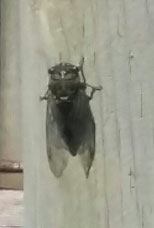Great Cicadas sightings from my backyard garden

This Past weekend I posted this query on Facebook about the Cicadas; Does anyone know the scientific name for this little fellow? Accompanied by the picture (shown here) and got some interesting answers in return. Some of the answers was as I expected, the usual suspects such as; Noisy bugs, a bug, quicket, (I supposed that was intended to be "Cricket") and; "that looks like a n...ayam bug". I myself knew it as this latter name. However,
The scientific name for this noisy bug is Cicadas.
This is the noisy bugs video that I shot when I saw them in my backyard garden on the weekend.
After posing the same question to the internet, well a version of it. Since I just inserted the words; noisy bugs in the search engine I got more than 21m hits for the term, and my question was answered.
Some Interesting Facts
Here now are some facts about this noisy little bug. according to our source; Wikipedid.
The cicadas are a superfamily of insects in the order Hemiptera (truebugs), some small species have songs so high in pitch that the noise is inaudible to the human ear.
After a rather lazy 13- 17 years spent relaxing underground, billions of incredibly noisy insects are about to burst out of the earth. Swarms of Magicicada—sometimes referred to as the annual fly or jar fly—rear up on the planet once every 13 or 17 years, depending on their location.
Magicicada do take a long time to mature: they spend those 17 long years growing from larvae into their full adult form, feeding on juice from plant roots along the way. Then, the fully grown adults emerge literally all at once, they and typically live for just weeks or months at the most.
This is an interesting video about the Cicadas that I found on my google search of; noisy bugs.
It is said that there are anywhere from 1300 to over 2,500 species of cicadas distributed worldwide with the majority being in the tropics. Most genera are restricted to a single biogeographical region and many species have a very limited range. This high degree of endemism has been used to study the biogeography of complex island groups such as in Indonesia and the Orient.
There are about 200 described species in Australia and New Zealand, around 150 in South Africa, over 170 in America north of Mexico, at least 800 in Latin America, and over 200 in Southeast Asia and the Western Pacific.
About 100 species occur in the Palaearctic ecozone. A few species are found in southern Europe, and a single species is in England, the New Forest Cicada, Melampsalta montana, which also occurs in continental Europe.
Most of the North American species are in the genus Neotibicen: the annual or jar fly or dog-day cicadas (so named because they emerge in late July and August). The best-known North American genus, however, is Magicicada.

Write a comment
psychic reading uk (Thursday, 15 December 2016 08:40)
cell
Cardioid Dynamic Microphone (Monday, 27 February 2017 03:41)
I have found best information with this blog thanks.